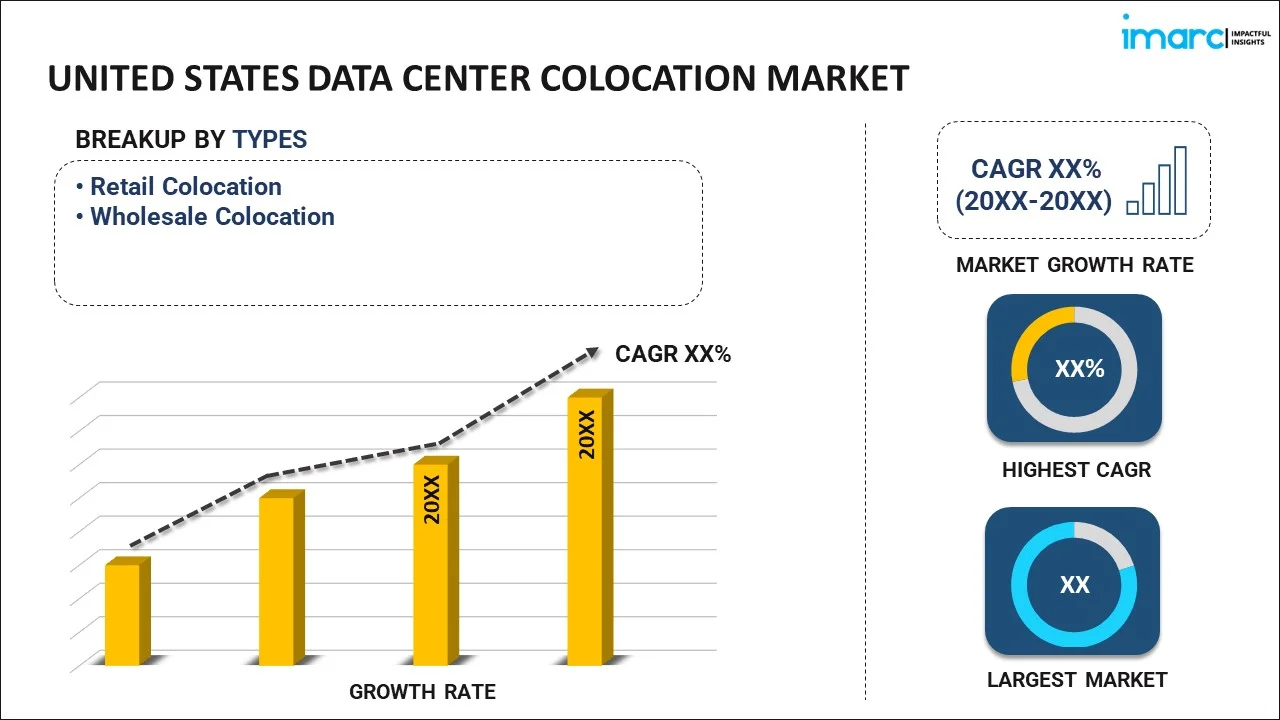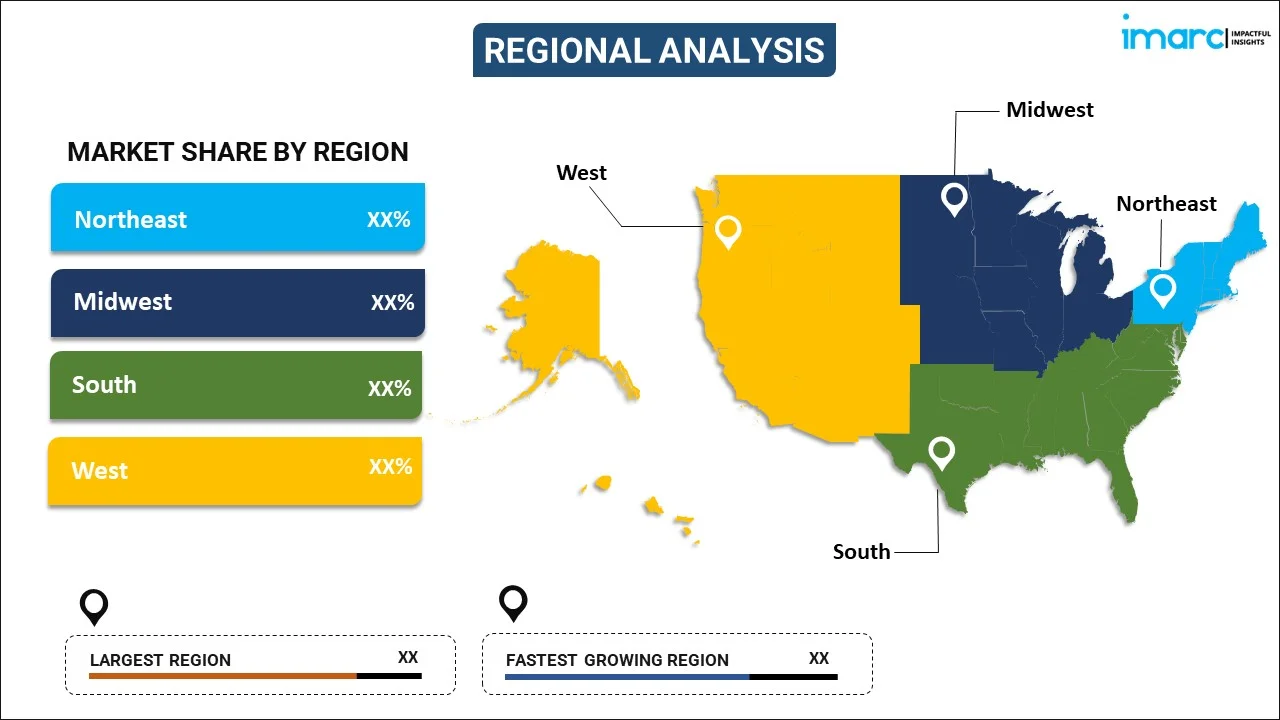
United States Data Center Colocation Market Report by Type (Retail Colocation, Wholesale Colocation), Organization Size (Small and Medium-sized Enterprises, Large Enterprises), End Use Industry (BFSI, Manufacturing, IT and Telecom, Energy, Healthcare, Government, Retail, Education, Entertainment and Media, and Others), and Region 2025-2033
Market Overview:
United States data center colocation market size reached USD 13.9 Billion in 2024. Looking forward, IMARC Group expects the market to reach USD 25.2 Billion by 2033, exhibiting a growth rate (CAGR) of 6.8% during 2025-2033. The inflating need for providing a flexible solution that can adapt to the evolving needs of businesses in an ever-changing technological landscape is primarily driving the market growth across the country.
|
Report Attribute
|
Key Statistics
|
|---|---|
|
Base Year
|
2024 |
|
Forecast Years
|
2025-2033
|
|
Historical Years
|
2019-2024
|
| Market Size in 2024 | USD 13.9 Billion |
| Market Forecast in 2033 | USD 25.2 Billion |
| Market Growth Rate (2025-2033) | 6.8% |
Data center colocation presents a solution wherein enterprises can rent physical space, network bandwidth, and various computing resources within an existing data center infrastructure. The rented space typically comes equipped with essential features such as power backup facilities, integrated networking components, information protocol (IP) systems, and cooling units, which are readily available in both retail and wholesale configurations. Companies widely embrace these services as they enhance business potential, allowing employees to concentrate on core functions while concurrently reducing overall operational costs. Renowned for their reliability and scalability, these solutions find extensive application across diverse industry verticals, including energy, retail, government, healthcare, and information technology (IT). The flexibility and efficiency offered by data center colocation make it a preferred choice for businesses aiming to optimize their operations and leverage shared infrastructure for enhanced performance and cost-effectiveness.
United States Data Center Colocation Market Trends:
The United States data center colocation market is experiencing significant growth as businesses increasingly recognize the advantages of outsourcing their computing infrastructure. This market offers enterprises the opportunity to rent space, networking resources, and computing capabilities within established data center facilities. Additionally, these colocation facilities often come equipped with crucial features like power backup, integrated networking components, information protocol (IP) systems, and efficient cooling units, which is acting as another significant growth-inducing factor. Besides this, companies across various industries in the U.S., including energy, retail, government, healthcare, and information technology, are turning to data center colocation services to enhance operational efficiency and reduce costs. The appeal lies in the ability to leverage shared infrastructure, allowing businesses to focus on core functions while minimizing the burden of managing and maintaining a dedicated data center. The U.S. data center colocation market's growth is further fueled by its scalability and reliability. Moreover, as the demand for secure and scalable data storage solutions continues to rise, the data center colocation market in the United States is poised for sustained expansion in the coming years.
United States Data Center Colocation Market Segmentation:
IMARC Group provides an analysis of the key trends in each segment of the market, along with forecasts at the country level for 2025-2033. Our report has categorized the market based on type, organization size, and end use industry.
Type Insights:

- Retail Colocation
- Wholesale Colocation
The report has provided a detailed breakup and analysis of the market based on the type. This includes retail colocation and wholesale colocation.
Organization Size Insights:
- Small and Medium-sized Enterprises
- Large Enterprises
A detailed breakup and analysis of the market based on the organization size have also been provided in the report. This includes small and medium-sized enterprises and large enterprises.
End Use Industry Insights:
- BFSI
- Manufacturing
- IT and Telecom
- Energy
- Healthcare
- Government
- Retail
- Education
- Entertainment and Media
- Others
The report has provided a detailed breakup and analysis of the market based on the end use industry. This includes BFSI, manufacturing, IT and telecom, energy, healthcare, government, retail, education, entertainment and media, and others.
Regional Insights:

- Northeast
- Midwest
- South
- West
The report has also provided a comprehensive analysis of all the major regional markets, which include the Northeast, Midwest, South, and West.
Competitive Landscape:
The market research report has also provided a comprehensive analysis of the competitive landscape in the market. Competitive analysis such as market structure, key player positioning, top winning strategies, competitive dashboard, and company evaluation quadrant has been covered in the report. Also, detailed profiles of all major companies have been provided.
United States Data Center Colocation Market Report Coverage:
| Report Features | Details |
|---|---|
| Base Year of the Analysis | 2024 |
| Historical Period | 2019-2024 |
| Forecast Period | 2025-2033 |
| Units | Billion USD |
| Scope of the Report | Exploration of Historical and Forecast Trends, Industry Catalysts and Challenges, Segment-Wise Historical and Predictive Market Assessment:
|
| Types Covered | Retail Colocation, Wholesale Colocation |
| Organization Sizes Covered | Small and Medium-sized Enterprises, Large Enterprises |
| End Use Industries Covered | BFSI, Manufacturing, IT and Telecom, Energy, Healthcare, Government, Retail, Education, Entertainment and Media, Others |
| Regions Covered | Northeast, Midwest, South, West |
| Customization Scope | 10% Free Customization |
| Post-Sale Analyst Support | 10-12 Weeks |
| Delivery Format | PDF and Excel through Email (We can also provide the editable version of the report in PPT/Word format on special request) |
Key Questions Answered in This Report:
- How has the United States data center colocation market performed so far and how will it perform in the coming years?
- What has been the impact of COVID-19 on the United States data center colocation market?
- What is the breakup of the United States data center colocation market on the basis of type?
- What is the breakup of the United States data center colocation market on the basis of organization size?
- What is the breakup of the United States data center colocation market on the basis of end use industry?
- What are the various stages in the value chain of the United States data center colocation market?
- What are the key driving factors and challenges in the United States data center colocation?
- What is the structure of the United States data center colocation market and who are the key players?
- What is the degree of competition in the United States data center colocation market?
Key Benefits for Stakeholders:
- IMARC’s industry report offers a comprehensive quantitative analysis of various market segments, historical and current market trends, market forecasts, and dynamics of the United States data center colocation market from 2019-2033.
- The research report provides the latest information on the market drivers, challenges, and opportunities in the United States data center colocation market.
- Porter's five forces analysis assist stakeholders in assessing the impact of new entrants, competitive rivalry, supplier power, buyer power, and the threat of substitution. It helps stakeholders to analyze the level of competition within the United States data center colocation industry and its attractiveness.
- Competitive landscape allows stakeholders to understand their competitive environment and provides an insight into the current positions of key players in the market.
Need more help?
- Speak to our experienced analysts for insights on the current market scenarios.
- Include additional segments and countries to customize the report as per your requirement.
- Gain an unparalleled competitive advantage in your domain by understanding how to utilize the report and positively impacting your operations and revenue.
- For further assistance, please connect with our analysts.
 Inquire Before Buying
Inquire Before Buying
 Speak to an Analyst
Speak to an Analyst
 Request Brochure
Request Brochure
 Request Customization
Request Customization




.webp)




.webp)












